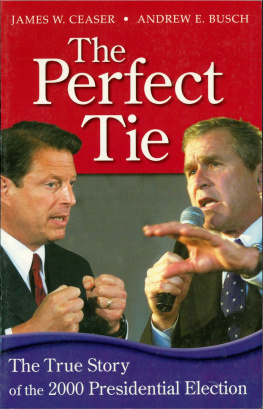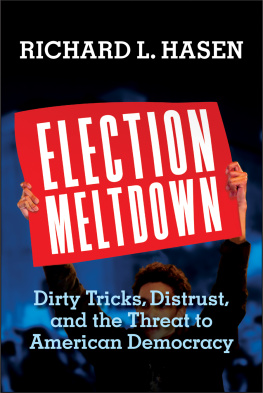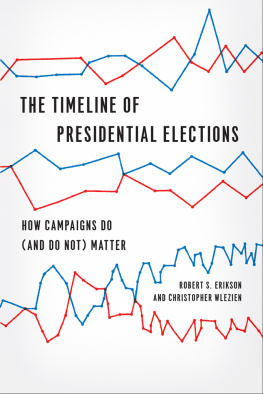Notes
Chapter 1
1. Anthony King, Running Scared: Why Americas Politicians Campaign Too Much and Govern Too Little (New York: Martin Kessler, 1997).
2. See Bruce Cain, John Ferejohn, and Morris Fiorina, The Personal Vote: Constituency Service and Electoral Independence (Cambridge, MA: Harvard University Press, 1987), p. 13; and Leon D. Epstein, Political Parties in Western Democracies (New York: Praeger, 1967), p. 43.
3. Richard Boyds research suggests that heavy demands on U.S. voters may be depressing participation in any one election. In the Connecticut town he studied, he found that more people voted at some time during the year than voted in any given election: a system that holds elections as frequently as we do in the United States must expect that even citizens who are attentive to politics and its obligations will not be at the polls every election. I would argue, then, that the frequency of elections in the United States is one explanation of the somewhat lower voting rate we experience in any given election compared to European countries. Richard W. Boyd, Decline of U.S. Voter Turnout: Structural Explanations, American Politics Quarterly 9 (April 1981): 13359. Switzerland, the other low-turnout democracy, also has frequent elections, and referendums; see David Butler and Austin Ranney, eds., Referendums around the World: The Growing Use of Direct Democracy (Washington, DC: AEI Press, 1994). In Running Scared, Anthony King argues that the U.S. pattern of frequent elections has important consequences for governing. Note also that turnout in recent European Union elections was substantially lower than national elections in most European countries; the 2004 EU election featured an overall turnout rate of under 50 percent. See Robert Anderson, Christopher Condon, and Stefan Wagstyl, Apathy Rules among Newest Member States, Financial Times, June 15, 2004, p. 14.
4. See Steven J. Rosenstone and John Mark Hansen, Mobilization, Participation, and Democracy in America (New York: Macmillan, 1993), pp. 17879.
5. A summary of these trends is a central topic in Steven E. Schier and Todd E. Eberly, American Government and Popular Discontent: Stability without Success (New York: Routledge, 2013). See also Matthew J. Hetherington, Why Trust Matters: Declining Political Trust and the Demise of Political Liberalism (Princeton, NJ: Princeton University Press, 2006).
6. Raymond E. Wolfinger, David P. Glass, and Peverill Squire, Predictors of Electoral Turnout: An International Comparison, Policy Studies Review 9 (Spring 1990): 55174, at 555, based on vote validated data from the 1980 National Election Studies.
7. Ibid., pp. 14650. Americans do least well on trust in government questions, but respond much more positively to questions about their efficacy (rejecting such statements as people like me have no say in what the government does) and to questions asking if a political party expresses their point of view.
8. Peverill Squire, Raymond E. Wolfinger, and David P. Glass, Residential Mobility and Voter Turnout, American Political Science Review 81 (March 1987): 4584.
9. Orley Ashenfelter and Stanley Kelley Jr., Determinants of Participation in Presidential Elections, Journal of Law and Economics 18 (December 1975): 695733. The prospect of partisan manipulation of purge laws by politicians seeking to disenfranchise likely supporters of the opposition has become an area of concern among some government watchdog groups over the past several years; see Myrna Perez, Voter Purges, Brennan Center for Justice at New York University, September 2008, http://www.brennancenter.org/page/-/publications/Voter.Purges.f.pdf.
10. The U.S. Election Assistance Commission reported that there were 194 million registered voters as of 2012, with 23 million of these classified as inactive voters (probably reflecting voters who had moved or died but had not yet been purged from the voting rolls). See U.S. Election Assistance Commission, 2012 Election Administration and Voting Survey: A Summary of Key Findings, September 2013, http://www.eac.gov/assets/1/Page/990-050%20EAC%20VoterSurvey_508Compliant.pdf, p. 6. The general outline of this argument has been known for over seventy-five years. For example, Harold Gosnell wrote in 1930 that [i]n the European countries studied, a citizen who is entitled to vote does not, as a rule, have to make any effort to see that his name is on the list of eligible voters. The inconvenience of registering for voting in this country has caused many citizens to become non-voters. Harold G. Gosnell, Why Europe Votes (Chicago: University of Chicago Press, 1930), p. 185. See also Raymond E. Wolfinger and Steven J. Rosenstone, Who Votes? (New Haven, CT: Yale University Press, 1980); G. Bingham Powell Jr., American Voter Turnout in Comparative Perspective, American Political Science Review 80 (March 1986): 1743; and Glenn E. Mitchell and Christopher Wlezien, The Impact of Legal Constraints on Voter Registration, Turnout, and the Composition of the American Electorate, Political Behavior 17 (June 1995): 179202.
11. This is presumably pegged to completion of the harvest in the colonial Northeast.
12. Stanley Kelley Jr., Richard E. Ayres, and William G. Bowen, Registration and Voting: Putting First Things First, American Political Science Review 61 (June 1967): 35979, at 37475.
13. In Richard E. Ayres, Registration 1960: Key to a Democratic Victory? (unpublished senior thesis, Princeton University, 1964), cited in Kelley, Ayres, and Bowen, Registration and Voting, p. 375, the author notes the correlation between convenience of registration and percent of the vote for the Democratic Party as proof of the Chicago Daley machines awareness of this phenomenon.
14. Dunn v. Blumstein, 405 U.S. 330 (1972); Burn v. Forston, 410 U.S. 686 (1972); and Marston v. Lewis, 410 U.S. 759 (1973).
15. Benjamin Highton and Raymond E. Wolfinger, Estimating the Effects of the National Voter Registration Act of 1993, Political Behavior 20 (June 1998): 79104; see also Raymond E. Wolfinger and Jonathan Hoffman, Registering and Voting with Motor Voter, PS: Political Science and Politics 34 (March 2001): 8592.
16. Stephen Knack and James White, Election-Day Registration and Turnout Inequality, Political Behavior 22 (March 2000): 2944. Not all of this difference can be explained by registration laws, however; see Benjamin Highton, Easy Registration and Voter Turnout, Journal of Politics 59 (May 1997): 56575.
17. California Secretary of State Debra Bowen, Statement of Vote, November 6, 2012, General Election, http://www.sos.ca.gov/elections/sov/2012_general/sov_complete.pdf, p. 3.
18. Figures from Michael P. McDonald, United States Elections Project, George Mason University, http://elections.gmu.edu/early_vote_2012.html.
19. The Sentencing Project, Felony Disenfranchisement Laws in the United States, March 2010, http://www.sentencingproject.org/doc/publications/fd_bs_fdlawsinusMarch2010.pdf.
20. McDonalds figures are available at http://elections.gmu.edu/Turnout_2012G.html. See also Michael P. McDonald and Samuel L. Popkin, The Myth of the Vanishing Voter, American Political Science Review 95 (December 2001): 96374, in which the authors argue that the muchlamented decline in electoral turnout rates after the 1960s was largely due to the growth of the ineligible population.
21. Paul E. Meehl, The Selfish Voter Paradox and the Thrown-Away Vote Argument, American Political Science Review 71 (March 1977): 1130.
22. The classic statement of this view is that of Anthony Downs, whose best effort is: The advantage of voting per se is that it makes democracy possible. If no one votes, then the system collapses because no government is chosen. We assume that the citizens of a democracy subscribe to its principles and therefore derive benefits from its continuance; hence they do not want it to collapse. For this reason they attach value to the act of voting per se and receive a return from it. Downs,





